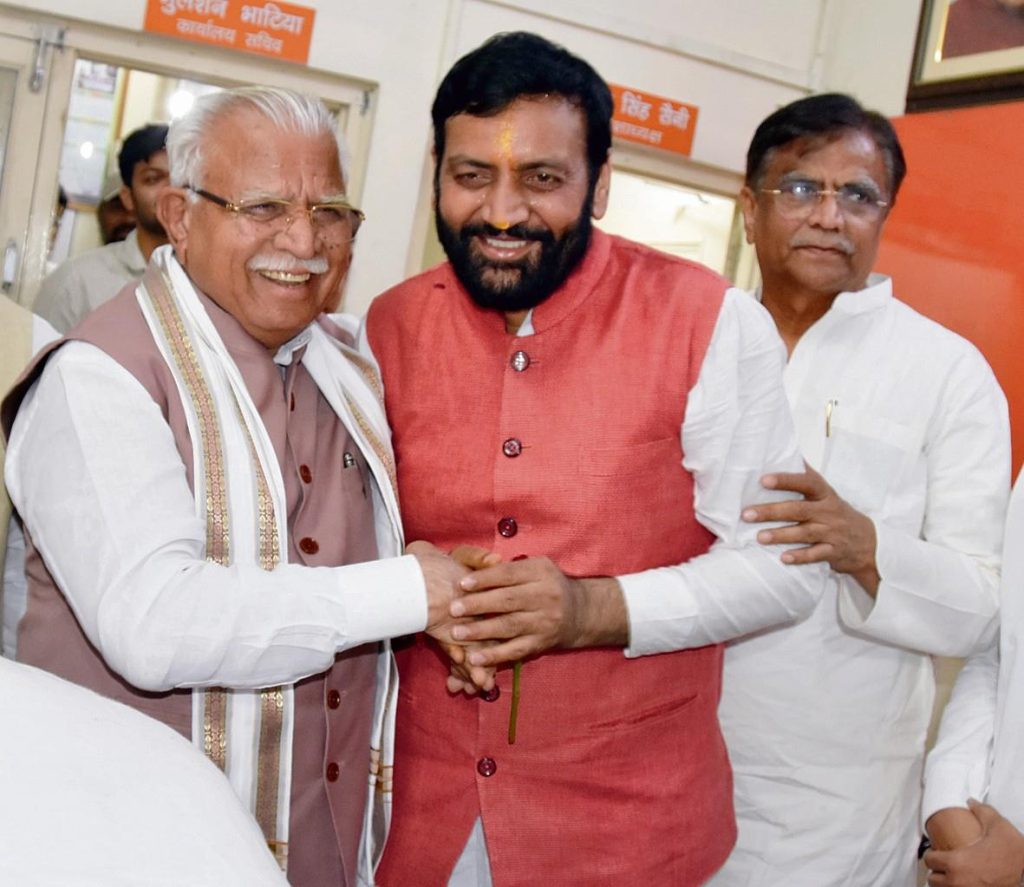
OBC vote arithmetic and anti-incumbency are cited to be the key reasons behind the BJP’s dramatic move to replace Haryana CM Manohar Lal Khattar with the party’s state president, 54-year-old Nayab Singh Saini ahead of Lok Sabha and assembly elections. A report by Aayush Goel
Following its tried and tested script which led to victory in three states, BJP went ahead replacing Haryana CM Manohar Lal Khattar with BJP state chief 54-year-old Nayab Singh Saini right before assembly and Lok Sabha elections. The resignation of CM along with entire cabinet after snapping ties with coalition partner Jannayak Janta Party (JJP) has been dubbed as a masterstroke by political experts to counter any anti-incumbency against 10 years of Khattar rule, splitting Jat votes and wooing Other Backward Class (OBC) communities. The opposition Congress however dubs it as acceptance of defeat ahead of the Parliamentary and state elections.
The political drama unfolded in state on March 12 within 12 hours of PM Narendra Modi taking to the mighty Dwarka Expressway for road show and showering numerous praises on Khattar. The dramatic developments of the day that began with the collapse of the BJP-JJP alliance, the BJP, with 41 MLAs in the 90-member House and the support of six independents was unruffled and presented governor Bandaru Dattatreya a list of 48-members who support the government. While it appeared sudden, the former CM said that they just followed a winning tradition to bring in new leadership. “It happened in Madhya Pradesh, Rajasthan, Chhattisgarh. In fact, I myself had suggested to the party high command that time has come for a new leadership to take over in Haryana’’, Khattar said.
It may be noted that BJP has also replaced CMs of Gujarat (Bhupendra Patel replaced Vijay Rupani), Uttarakhand (Pushkar Singh Dhami replaced Tirath Rawat), Tripura (Manik Saha replaced Biplab Dev) where the party won but replacing B. S Yediyurappa with Basvaraj Bommai in Karnataka led to the BJP’s defeat in assembly polls.
“Our newly formed cabinet wants to thank former CM Manohar Lal Khattar. He has given Haryana a new direction and has given the best example of good governance. He did development work in the state without any discrimination,” said the newly elected CM Saini. Saini was sworn in along with BJP’s Kanwar Pal (Jagadhari), Mool Chand Sharma (Ballabhgarh), Jai Parkash Dalal (Loharu) and Banwari Lal (Bawal), and Independent MLA Ranjit Singh Chautala (Rania). They were all part of Khattar’s council as well and there are still 8 seats vacant. The realignment faced a hiccup as former state home minister Anil Vij did not attend the swearing-in ceremony amid speculation that he was upset with the change of guard. Vij had also walked out of the legislature party meeting where Saini was “unanimously” named the CM-designate.
Khattar issued a statement saying that Vij’s name was on the list of new ministers to be sworn in at the Raj Bhavan ceremony, but the MLA decided to skip it. The former CM indicated that both he and Saini will talk to Vij later to persuade him to accept a place in the cabinet. Vij is not leaving the party however as he said that he had stood by the party during all changes and will do so this time as well.
Who is Nayab Singh Saini
Nayab Singh Saini comes from the OBC community and last year he was made the state president of Haryana BJP. Saini is considered a confidant of Khattar. Saini has long experience of working in the organisation. In 1996, he was given responsibility in the organization of Haryana BJP. After that, in 2002, Nayab Singh Saini became the district general secretary of Ambala BJP Yuva Morcha. In 2005, he became the district president of BJP Ambala Yuva Morcha. He was also made the state general secretary of BJP Haryana Kisan Morcha. In 2012, Saini was promoted and was made the district president of Ambala and in the 2014 assembly elections, he was given a ticket from Naraingarh and he reached the assembly after winning. He graduated with a B.A. from BR Ambedkar University, Muzaffarpur, Bihar in 1996 and LLB from Choudhary Charan Singh University, Meerut (UP) in the year 2010.
Key challenges
While the plan may have been perfectly executed by BJP but Saini has his own set of challenges as he will be racing against time with poll code of conduct being in place. Saini’s biggest challenge will be to lead the BJP into 2024 assembly elections and help it tide over a strong anti-incumbency sentiment. With the Haryana assembly elections due in October this year and the model code of conduct for Lok Sabha elections likely to be imposed anytime now, Saini would have little time to set his image and realise party goals on hot seats. He will, at least for initial phases, be guided by his predecessors and his aides and will be up for backseat driving and may become a lame duck in view of the time limitations he has.
Congress slams ‘scripted move’
Former CM and Congress leader Bhupinder Singh Hooda said that so far as the snapping of ties with the JJP was concerned, he “had said a week back that the BJP and the JJP had entered into a new agreement to divide opposition votes. But by changing the chief minister, the BJP has accepted its defeat.” “The BJP-JJP government led by Khattar failed on all fronts. People were unhappy and are waiting to oust this government in the assembly election this year. By changing the CM, the BJP has tried to cover up its failures by bringing in a new face, but this is not going to help,” said Hooda. Congress general secretary Randeep Singh Surjewala, too, tweeted that the BJP enacted “a pre-arranged drama” of snapping ties with the JJP to save itself from the consequences of the failures while Kumari Selja, another general secretary of the Congress, described the act of replacing Khattar with Saini as a “repackaging” to fool the voters.
What caused BJP-JJP split
The BJP-JJP split is believed to have been triggered by disagreement over seat-sharing for the summer’s Lok Sabha elections; the BJP, which has 10 incumbent MPs in all 10 parliamentary constituencies in the state, was unwilling to share Lok Sabha seats with the JJP. The number of seats sought by JJP had not been disclosed by either side, while there has been no discussion on assembly seats. Political experts claim that BJP now has the numbers and no longer requires JJP which, according to many BJP leaders, was becoming more demanding since 2019.
“We abided by gathbandhan Dharam (code of conduct for coalition) and worked for people. They backed out. Our party was preparing for two Lok Sabha seats, Bhiwani-Mahendragarh and Hisar but BJP couldn’t be fair enough. BJP had asked me to contest from the Rohtak Lok Sabha seat. This cannot break us. Our party will now contest both Lok Sabha and Vishan Sabha and in the state we will win over 50 seats. We just want people’s support as that is the true power,” said former Dy CM Dushyant Chautala at his rally in Hisar. BJP announced Manohar Lal Khattar’s candidature from Karnal Lok Sabha seat.
Vote arithmetic
One of the key reasons behind the change has been cited as OBC vote arithmetic. Though there is no authentic data of the caste-wise population in Haryana, various estimates put the population of backward classes at 35 percent. The Dalits and the general caste, including the Jats, comprise nearly 20 percent and 45 percent, respectively. While Saini will bring in OBC votes, Jats represent approximately 20 percent of the state’s population. Over the years, the political landscape of Haryana has been primarily dominated by the Jats. Khattar had fallen out of favour of them during 2020-21 farmers agitation, the wrestlers’ protest and action against Punjab farmers on Haryana borders of late. The snapping of ties with JJP implies that the votes of the Jats, the most populous community in the state, are likely to be divided among the Congress, the JJP and the Indian National Lok Dal (INLD).












